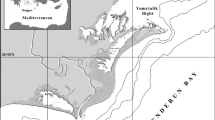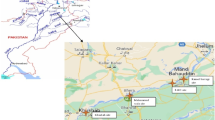Abstract
Bioindicator value of digenean parasites (Acanthostomum absconditum, Acanthostomum spiniceps and Haplorchoides cahirinus) of silver catfish, Bagrus bajad was assessed by analyzing the concentrations of nine heavy metals (Fe, Zn, Cu, Ni, Cd, Cr, Mn, Co, and Pb) using atomic absorption spectrometry. Additionally, the study compared heavy metals concentrations in four sinks (water, gills, intestine and digenean worms) from two aquatic habitats (the upstream and downstream) of the Damietta Branch of the River Nile from January to December, 2018. The results revealed that iron and manganese were the most abundant metals in water, gills, intestine and digenean worms at both the upstream and downstream aquatic habitats. In addition, the digenean worms of B. bajad inhabiting these two localities accumulated higher amounts of all analyzed heavy metals than water, gills and intestine (especially iron and manganese), except for chromium, the highest level of which was encountered in the gill tissues. The seasonal variations of heavy metals indicated their highest concentration in summer (for water, gills, intestine and digenean worms) and lowest concentration in autumn and winter (for water, gills and intestine), and in winter and spring (for digenean parasites). The results confirmed that the digenean intestinal parasites accumulate heavy metals pollutants in a significant manner and are important model for monitoring pollution.










Similar content being viewed by others
References
Adham KG, Hassan IF, Taha N, Amin TH (1999) Impact of hazardous exposure to metals in the Nile and Delta lakes on the catfish, Clarias lazera. Environ Monit Assess 54(2):107–124. https://doi.org/10.1023/A:1005898430980
Adimalla N, Chen J, Qian H (2020) Spatial characteristics of heavy metal contamination and potential human health risk assessment of urban soils: a case study from an urban region of South India. Ecotoxicol Environ Saf 194:110406
Al-Hasawi ZM (2019) Environmental Parasitology: intestinal helminth parasites of the siganid fish Siganus rivulatus as bioindicators for trace metal pollution in the Red Sea. Parasite 26:12. https://doi.org/10.1051/parasite/2019014
Ali H, Khan E, Ilahi I (2019) Environmental chemistry and ecotoxicology of hazardous heavy metals: environmental persistence, toxicity, and bioaccumulation. J Chem 2019:6730305. https://doi.org/10.1155/2019/6730305
Allen SE, Grimshaw HM, Parkinson JA, Quarmby C (1974) Chemical analysis of ecological materials. Blackwell Scientific Publications, Hoboken
Chishti KA, Khan FA, Shah SMH (2011) Estimation of heavy metals in the seeds of blue and white capitulum’s of silybum marianum grown in various districts of Pakistan. J Basic Appl Sci 7:45–49
El-Naggar AM, Abdeen SH, Hagras AE (2016) Impacts of fluctuations of physicochemical environmental parameters of aquatic ecosystems on somatic indices and sex hormones of the teleosts Clarias gariepinus and Oreochromis niloticus. J Biosci Appl Res 2(1):670–685
El-Naggar AM, Mashaly MI, Hagras AE, Alshafei HA (2017) Monogenean microfauna of the Nile Catfish, Clarias gariepinus as Biomonitors of environmental degradation in aquatic ecosystems at the Nile Delta, Egypt. IOSR-JESTFT 11(8):45–62. https://doi.org/10.9790/2402-1108014562
El-Sayed ES, Khater Z, El-Ayyat M, Nasr ES (2011) Assessment of heavy metals in water, sediment and fish tissues, from, Sharkia province, Egypt. Egypt J Aquat Biol Fish 15:125–144
Faroon O, Keith S (2004) Toxicological profile for cobalt. Public health service, agency for toxic substances and disease registry. US Department of Health and Human Services, Washington, D.C., p 486
Gad NS (2010) Corganochlorine pesticides and trace metals contamination in some marketable fish in Egypt. Egypt J Aquat Res 36:631–640
Gao Q, Nie P (2000) Lead content in the monogenean, Ancyrocephalus mogurndae and in different organs of its host, the mandarin fish, Spiniperca chuatsi. Zhongguo Huanjing Kexue 20(3):233–236
Kapustka LA (2004) Issue paper on the ecological effects of metals. US Environmental Protection Agency, Washington, DC, p 77
Malek M, Haseli M, Mobedi I (2007) Parasites as heavy metal bioindicators in the shark Carcharhinus dussumieri from the Persian Gulf. Parasitology 134(7):1053–1056. https://doi.org/10.1017/S0031182007002508
Mashaly MI, Allam HE, El-Naggar MM (2020) Impacts of physicochemical and heavy metal parameters on infestation level of the monogeneans, Quadriacanthus spp infesting Nile catfish, Clarias gariepinus of different water localities in Nile Delta, Egypt. J Parasit Dis 1:2. https://doi.org/10.1007/s12639-020-01231-7
Maurya PK, Malik DS, Yadav KK (2019) Bioaccumulation and potential sources of heavy metal contamination in fish species in River Ganga basin: possible human health risks evaluation. Toxicol Rep 6:472–481. https://doi.org/10.1016/j.toxrep.2019.05.012
Mekkawy IAA, Mahmoud UM, Ibrahim ATA (2008) Heavy metal distribution and their corresponding damage effect in some organs of Bagrus bajad (Forsskal, 1775) from three localities at Assiut, Egypt. Egypt J Egypt Ger Soc Zool 54:119–137
Mondal M, Kundu JK, Misra KK (2016) Variation in lipid and fatty acid uptake among nematode and cestode parasites and their host, domestic fowl: host–parasite interaction. J Parasit Dis 40(4):1494–1518. https://doi.org/10.1007/s12639-015-0718-5
Moravec F (1976) On two acanthostomatid trematodes, Acanthostomum spiniceps (Looss, 1896) and A. absconditum (Looss, 1901), from African bagrid fishes. Folia Parasitol (Praha) 23(3):201–206
Nachev M, Sures B (2016) Environmental parasitology: parasites as accumulation bioindicators in the marine environment. J Sea Res 113:45–50. https://doi.org/10.1016/j.seares.2015.06.005
Najm M (2014) The study of heavy metals (Lead, Cadmium, Zinc and Chromium) concentration in Acantocephalan parasites collected from Gasterosteus aculeatus and Clupeonellad elicatulu fishes in Caspian Sea and comparison with their host tissues. M.Sc. thesis in Parasitology, School of Medicine, Mazandaran University of Medical Sciences
Najm M, Fakhar M (2015) Helminthic parasites as heavy metal bioindicators in aquatic ecosystems. Med Lab J 9(4):26–32. https://doi.org/10.18869/acadpub.mlj.9.4.26
Pandey G, Madhuri S (2014) Heavy metals causing toxicity in animals and fishes. Res J Anim Vet Fish Sci 2(2):17–23
Shah A, Niaz A, Ullah N et al (2013) Comparative study of heavy metals in soil and selected medicinal plants. J Chem 2013:5. https://doi.org/10.1155/2013/621265.621265
Shahat MA, Amer OSO, Abd Allah AT et al (2011) The distribution of certain heavy metals between intestinal parasites and their fish hosts in the River Nile at Assuit Province, Egypt. Egypt J Hosp Med 31:1–34. https://doi.org/10.12816/EJHM.2011.16783
Sures B (2001) The use of fish parasites as bioindicators of heavy metals in aquatic ecosystems: a review. Aquat Ecol 35(2):245–255. https://doi.org/10.1023/A:1011422310314
Sures B (2003) Accumulation of heavy metals by intestinal helminths in fish: an overview and perspective. Parasitology 126(7):S53–S60. https://doi.org/10.1017/S003118200300372X
Sures B (2004) Environmental parasitology: relevancy of parasites in monitoring environmental pollution. Trends Parasitol 20(4):170–177. https://doi.org/10.1016/j.pt.2004.01.014
Sures B, Siddall R (1999) Pomphorhynchus laevis: the intestinal acanthocephalan as a lead sink for its fish host, chub (Leuciscus cephalus). Exp Parasitol 93(2):66–72. https://doi.org/10.1006/expr.1999.4437
Sures B, Taraschewski H (1995) Cadmium concentrations in two adult acanthocephalans, Pomphorhynchus laevis and Acanthocephalus lucii, as compared with their fish hosts and cadmium and lead levels in larvae of A. lucii as compared with their crustacean host. Parasitol Res 81(6):494–497. https://doi.org/10.1007/BF00931792
Sures B, Taraschewski H, Jackwerth E (1994) Lead accumulation in Pomphorhynchus laevis and its host. J Parasitol 80(3):355–357. https://doi.org/10.2307/3283403
Sures B, Jürges G, Taraschewski H (1998) Research note Relative concentrations of heavy metals in the parasites Ascaris suum (Nematoda) and Fasciola hepatica (Digenea) and their respective porcine and bovine definitive hosts. Int J Parasitol 28:1173–1178
Sures B, Siddall R, Taraschewski H (1999) Parasites as accumulation indicators of heavy metal pollution. Parasitol Today 15(1):16–21. https://doi.org/10.1016/s0169-4758(98)01358-1
Sures B, Nachev M, Selbach C, Marcogliese DJ (2017) Parasite responses to pollution: what we know and where we go in ‘Environmental Parasitology’. Parasit Vectors 10(1):65. https://doi.org/10.1186/s13071-017-2001-3
Funding
This research did not receive any specific grant from funding agencies in the public, commercial, or not-for-profit sectors.
Author information
Authors and Affiliations
Corresponding author
Ethics declarations
Conflict of interest
The authors declare that they have no conflict of interest.
Ethical standards
The authors confirm that all procedures contributing to this work comply with the ethical standards of the relevant national and institutional guides on the care and use of laboratory animals.
Additional information
Publisher's Note
Springer Nature remains neutral with regard to jurisdictional claims in published maps and institutional affiliations.
Rights and permissions
About this article
Cite this article
Mashaly, M.I., El-Naggar, A.M., El-Tantawy, S.A. et al. Accumulation of nine heavy metals in water and gills, intestine and digenean parasites of the silver catfish, Bagrus bajad Forskål, 1775. J Parasit Dis 45, 490–501 (2021). https://doi.org/10.1007/s12639-020-01326-1
Received:
Accepted:
Published:
Issue Date:
DOI: https://doi.org/10.1007/s12639-020-01326-1




